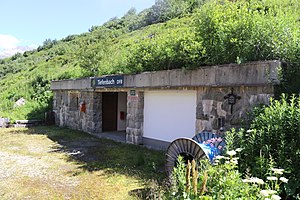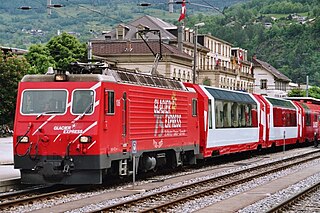
The Matterhorn Gotthard Bahn is a narrow gauge railway line and a railway company in Switzerland. The track width is 1,000 mm. It was created in 2003 through an amalgamation of Furka Oberalp Bahn (FO) and BVZ Zermatt-Bahn (BVZ). The name comes from the Matterhorn and St. Gotthard Pass.
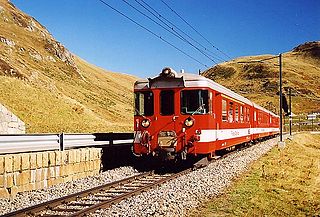
The Furka Oberalp Railway is a narrow gauge mountain railway in Switzerland with a gauge of 1,000 mm. It runs in the Graubünden, Uri and Canton of Valais. Since January 1, 2003, it is part of the Matterhorn Gotthard Bahn when it merged with the BVZ Zermatt-Bahn.
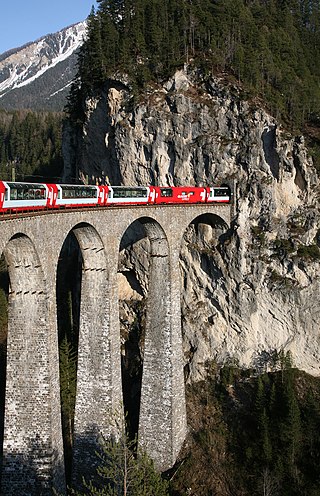
The Glacier Express is a direct train connecting railway stations of the two major mountain resorts of Zermatt and St. Moritz via Andermatt in the central Swiss Alps. The train provides a one-seat ride for an 8-hour end-to-end 291-kilometre (181 mi) journey, and omits stops made by local trains. The Glacier Express has been called the 'slowest express train in the world'. As St. Moritz and Zermatt are home to two well-known mountains, the Glacier Express is also said to travel from Matterhorn to Piz Bernina.

The Furka Base Tunnel is a Swiss railway base tunnel on the Matterhorn Gotthard Bahn's Furka–Oberalp line, an east–west railway connecting the cantons of Valais and Uri. Its west portal lies east of Oberwald (VS), at 1,390 m (4,560 ft) above sea level and its east portal lies south of Realp (UR), at 1,550 m (5,090 ft).

Furka Pass is a 2,429 m (7,969 ft) high mountain pass in the southern Swiss Alps connecting Gletsch, Valais with Realp, Uri via the seasonal Furkapassroute. The Furka Oberalp Bahn bypasses the pass through the 1,390 m (4,560 ft) high Furka Base Tunnel, which opened in 1982 to replace the seasonal Furka Summit Tunnel tunnel at 2,160 metres (7,090 ft).

Oberalp Pass is a high mountain pass in the Swiss Alps connecting the cantons of Graubünden and Uri between Disentis/Mustér and Andermatt.

Andermatt railway station is a railway station and junction on the metre gauge Furka Oberalp Bahn (FO), serving the town and municipality of Andermatt, in the canton of Uri, Switzerland. The station is connected, via the Furka Pass, with Brig and Visp in the canton of Valais, and, via the Oberalp Pass, with the western terminus of the Rhaetian Railway at Disentis/Mustér, in the canton of Graubünden. There is also a short branch line, the Schöllenenbahn, between Andermatt and Göschenen, at the northern end of the standard gauge Gotthard Rail Tunnel.
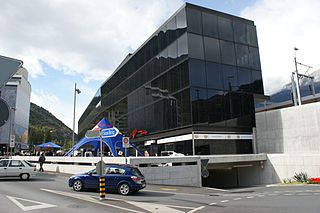
Visp railway station is a junction station at Visp, in the canton of Valais, Switzerland. It has a modern station building completed in 2007, and is served by two standard gauge lines and a metre gauge line.

The Furka Summit Tunnel is a 1.86 kilometres (1.16 mi) long railway tunnel in southern Switzerland. It lies at an altitude of 2,160 metres (7,090 ft). The summit tunnel was completed in 1925, and first opened on 3 July 1926. It links the Furka railway station, in Uri, with the Muttbach-Belvédère halting point, in Valais.
Furka Tunnel may refer to either of the following railway tunnels between Uri and Valais in Switzerland:

Realp railway station is a metre gauge station serving the municipality of Realp, in the Canton of Uri, Switzerland. The station is close to the eastern portal of the Furka Base Tunnel, on the Matterhorn Gotthard Bahn (MGB), which connects Brig in Valais, via Andermatt in Uri, with Göschenen, Uri, and Disentis/Mustér, Graubünden. Since 1 January 2003, the FO has been owned and operated by the Matterhorn Gotthard Bahn (MGB), following a merger between the FO and the Brig-Visp-Zermatt railway (BVZ).

Oberwald railway station is a railway station serving the village of Oberwald, in the Canton of Valais, Switzerland. The station is close to the western portal of the Furka Base Tunnel, on the metre gauge Furka Oberalp Bahn (FO), which connects Brig in Valais, via the base tunnel and Andermatt in Uri, with Göschenen, Uri, and Disentis/Mustér, Graubünden. Since 1 January 2003, the FO has been owned and operated by the Matterhorn Gotthard Bahn (MGB), following a merger between the FO and the Brig-Visp-Zermatt railway (BVZ).
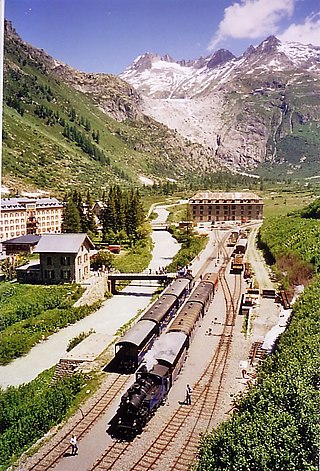
Gletsch railway station is a 1,000 mmmetre gauge metre gauge railway station serving the village of Gletsch, in the Canton of Valais, Switzerland.

Fiesch railway station is a metre gauge station serving the municipality of Fiesch, in the Canton of Valais, Switzerland. The station forms part of the Furka Oberalp Bahn (FO), which connects Brig in Valais, via Furka Base Tunnel, Andermatt in Uri, with Göschenen, Uri, and Disentis/Mustér, Graubünden. Since 1 January 2003, the FO has been owned and operated by the Matterhorn Gotthard Bahn (MGB), following a merger between the FO and the Brig-Visp-Zermatt railway (BVZ).

Furka DFB railway station is a metre gauge railway station at the eastern portal of the Furka Summit Tunnel, in the Canton of Uri, Switzerland. The station was opened in 1926. It was then owned and operated from that point until 1981 by the Furka Oberalp Bahn (FO), which connects Brig in Valais, via Andermatt in Uri, with Göschenen, Uri, and Disentis/Mustér, Graubünden.
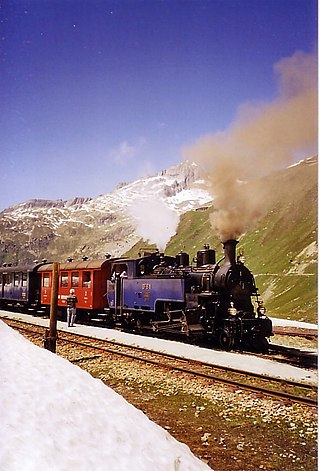
Muttbach-Belvédère railway station is a metre gauge railway passenger facility, at the western portal of the Furka Summit Tunnel, in the Canton of Valais, Switzerland.
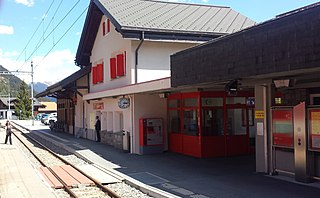
Sedrun railway station is a metre gauge railway station serving the village of Sedrun, in the Canton of Graubünden, Switzerland. The station is at the eastern end of the Oberalp Pass. It forms part of the Furka Oberalp Bahn (FO), which connects Brig in Valais, via Andermatt in Uri, with Göschenen, Uri, and, via the Oberalp Pass, with Sedrun and Disentis/Mustér, Graubünden.

The Furka Oberalp Bahn Ge 4/4 III, now known as the Matterhorn Gotthard Bahn Ge 4/4 III, is a two member class of metre gauge electric locomotives operated until 2002 by the Furka Oberalp Bahn (FO), and since then by its successor, the Matterhorn Gotthard Bahn, between the Cantons of Valais and Uri in southern Switzerland.

The Furka Steam Railway is a largely volunteer-operated heritage railway which operates a partially rack and pinion-operated line across the Furka Pass, between Realp in Uri and Oberwald in Valais. Culminating at 2,160 metres (7,087 ft), above sea level, it is an old mountainous section of the Furka Oberalp Bahn (FO) that was abandoned after the construction of the Furka Tunnel. It has been gradually brought back into service by the Verein Furka-Bergstrecke with the use of only steam locomotives, with the entire line completed in 2010. As a result, the nearly 18 kilometre-long Furka Railway is the longest operated unelectrified line in Switzerland. It is also the second highest rail crossing in Europe, after the Bernina Railway. The Uri side of the line also constitutes the highest railway in Central Switzerland.

Realp DFB railway station is a railway station in the municipality of Realp, in the Swiss canton of Uri. It is the eastern terminus of the Furka Steam Railway, a heritage railway that operates over the Furka Pass route. Regular service through the Furka Base Tunnel uses Realp railway station, roughly 400 metres (1,300 ft) to the north.
